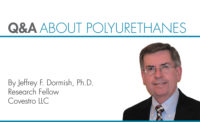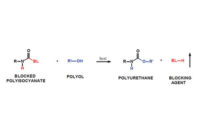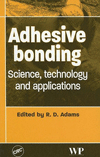Q&A About Polyurethanes
Consistent Performance in a Waterborne Polyurethane Adhesive
What should we do about inconsistent performance in a waterborne polyurethane adhesive?

Scaling up products from the laboratory to field trials to full production can often be problematic, whether a new polymer is being developed or a formulated finished adhesive is manufactured. If bond failures are occurring during production, the plant may go back to the adhesive supplier and claim the adhesive is at fault. However, it could be the case that the performance variability may be due to the manufacturing process rather than the quality of the adhesive. When the adhesive and the new application are in the development stage, special care is taken by the adhesive manufacturer to supply a consistent product, and the field trials are conducted under well-controlled conditions.
Let’s explore the potential pitfalls in the use of a two-component waterborne polyurethane that is crosslinked with a polyisocyanate. Adhesives of this type are used in furniture and automotive applications. The adhesive needs to develop high bond strength in a short period of time, which often means minutes rather than of hours.
Critical steps must be carried out dependably all along the manufacturing line to have success. The adhesive must first be applied with a sufficient coat weight. This is particularly important with a porous wood substrate to prevent a starved bond line.
For an automotive application, when bonding to a nonporous substrate the water must have sufficient time to evaporate or it will be trapped in the bond line and lead to failures. Polyurethane dispersions that develop strength rapidly are commonly composed of a crystalline polyester backbone. These types of polymers yield a dry and non-tacky film when applied. This film must be warmed to soften and decrystallize the polymer backbone, at which point the adhesive is ready for bonding. The adhesive layer must be soft enough to wet out the substrate but shouldn’t be too hot. Excessive heat in the bond line will prevent the rapid cooling and recrystallization of the adhesive, which is integral to fast bond strength development. A high ambient temperature in the plant can also slow the recrystallization rate. The substrates being joined must also be held in the press for sufficient time and with the appropriate pressure to allow the bond to form.
The water dispersible polyisocyanate needs to be combined with the polyurethane dispersion in the correct ratio, and it must be mixed with sufficient energy to be properly dispersed. Hand stirring is usually not sufficient. It is also important not to put too much power into mixing by using a high-speed disperser blade. This will produce very small dispersed droplets of the polyisocyanate. Small droplets produce a larger surface area of polyisocyanate that is exposed to water and will lead to a shorter pot life. In the extreme case, the dispersion itself can be destabilized when exposed to very high shear conditions. Another key point is that the pot life of 4-8 hrs must not be exceeded. The polyisocyanate water reaction could progress to the point that there is insufficient crosslinker remaining to cure the polyurethane polymer.
It is important to have experienced technical service staff present during initial production to observe how the adhesive is being processed and to educate the manufacturer on the use of this new product. For all to be successful, the adhesive supplier and the user of the adhesive must have a strong, positive working relationship. ASI
Any views or opinions expressed in this column are those of the author and do not represent those of ASI, its staff, Editorial Advisory Board or BNP Media.
Looking for a reprint of this article?
From high-res PDFs to custom plaques, order your copy today!









